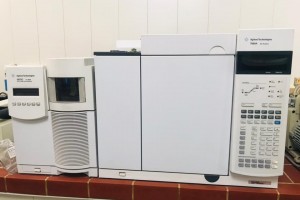
The College of Education for Pure Sciences, Department of Chemistry, discussed a master’s thesis on the preparation of a series of azo dyes derived from methyl 2-aminobenzoate and some of its polymers, and the study of their analytical and biological applications.
The message submitted by the researcher (Ali Zaboun Salman) included:
The study is to prepare azo compounds (A4-A1) from its reactant aromatic amine (2-aminobenzoate methyl) by nitrification and conjugation with pharmaceutical phenolic compounds (pyridoxine hydrochloride, ortho-vanillin, para-vanillin, and kojic acid). Then, the compound (A4) is converted into new ester polymers by Its reaction with succinic acid and apic acid.
All compounds and polymers were then characterized by IR, UV-Vis, mass spectrometry and 1H NMR spectroscopy.
Also, a solid complex of copper (II) was prepared with the azo compound A1 and it was characterized by infrared spectroscopy and measurements of the percentage of copper (II) using flame atomic absorption spectroscopy, as well as molar conductivity and thermogravimetric analysis.
Then it included a spectroscopic study of the azo compounds (A4-A1). At the same time, the prepared polymers were studied spectroscopically in the same way in the visible region with a range of wavelengths (520-330) nanometers to determine the extent to which these spectral properties remained in the prepared polymers.
The visible-ray spectra of azo compounds were also studied with a group of different polar solvents (n-hexane, 1,4-dioxane, chloroform, acetone, ethanol, methanol, dimethyl sulfoxide, and deionized water) with a range of wavelengths (330-550 nm).
The effect of pH on the electronic absorption spectra of azo compounds (A4-A1) was studied in the visible region, with a range of wavelengths (330-530) nm, using different buffer solutions with different pH values (12-2). The constants for protonation and ionization were calculated using the mid-height method, and the isopest points and proposed ionization and protonation mechanics were determined.
It also included a spectroscopic study of the copper (II) complex with the azo compound (A1), and it was noted that the color of the complex was (red) after the color of the azo compound in question was orange. The effect of pH was studied with a range of buffer solutions (12-2). The optimal conditions for the formation of this complex were determined, including determining the maximum wavelength, which was (520) nanometers in the acidic solution (pH 10) for its complex with copper (II), and the effect of time was studied. From (2880-1) minutes.
The study also examined the applicability of Beer's law and the sensitivity of the spectroscopic method to the azo compound (A1) with copper (II). The value of the molar absorption coefficient (ɛ) was (2.48 x 104) lmol.1-cm-1, the value of the specific absorbance coefficient (a) was (0.004) mg-1.cm-1, and the Sandel sensitivity (S) was (0.263) micrograms. cm-2, standard deviation (S.D) values (0.0004), and detection limit (DL) (0.034) µg.ml-1.
The effect of the interference of some important ions (K+, Na+, Ag+, Ti+, Ni+2, Co+2, Mg+2, Mn+2, Cd+2, Cu+2, Hg+2, Ba+2, Pb+2, and Fe+) was studied. 2, VO+2, Cr+3, Ai+3, Bi+3, Cl-, NO3-, SO4-2, and PO4-3) which can interfere and affect the absorption value of the copper (II) complex with the azo compound ( A1).
Finally, the thermal analysis of the prepared ester polymers (p1 and p2) was studied, and it was found through the study that the polymers have high thermal stability. The biological effectiveness of all azo compounds (A4-A1) and the copper (II) complex with the azo compound (A1) against two types of bacteria was also studied. They are (Staphylococcus aureus and Escherichia coli).









